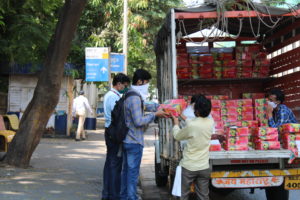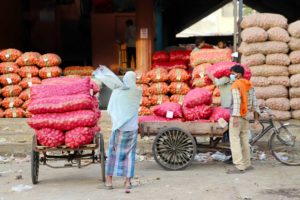Rural India bears the brunt of coronavirus fallout

The lockdown has hit Indian farmers hard as they face real prospects of seeing their harvest rot in the field in the absence of transport
While the spread of covid-19 has mainly been in urban India, the worst impact of the pandemic is being felt in its villages.
Driving on a rather deserted Eastern Expressway, one of the principal arteries of India’s business capital, Mumbai, an unusual sight greets your correspondent. Just before the exit from Mumbai and entry into Thane, the largest suburb, a small truck is parked at an intersection and a few people are gathered around it, buying boxes of freshly grapes.
Sitting atop the open back of the truck is Basant Rane, a third-generation farmer from Sangamner, a small town about 230 km east of Mumbai in Ahmednagar district. Rane’s family has been into grape farming for generations and the family owns a vineyard that stretches over five acres. In a good year, the vineyard yields about 12 tonnes of the fruit, most of which is sold as table grapes, even though Nashik, India’s wine-making hub is barely 50 km away. Rane says that though the family is not rich, but a good harvest earns about INR 1.2 million, that is enough to generate a profit on which the family can manage reasonably well.
“Each year, even before the crop is ready for harvest, we have traders and buyers coming to the farm and ordering as per their needs. Very rarely did we have any grapes left to even sell in the local market,’’ Rane tells Media India Group.
But that was life before coronavirus. Rane finds his life turned upside down since early March when the pandemic began making inroads into India. But it is the lockdown, extremely unplanned and hastily imposed, that has totally crippled Rane and his family. “Before the lockdown began, we had already started harvesting and managed to pick over 5 tonnes of grapes. But since then even that is not possible as we don’t find any workers to help us with the harvest and we have little choice but to let it rot on the vines as we are focused on finding the buyers for the crop already picked,’’ he says.
But even more distressing for him is that for the first time in his life there were no buyers for the crop already harvested and he had to leave not just the farm, but also the town and drive over 200 km to Mumbai.
But even here in Mumbai, Rane had a tough time finding adequate number of buyers willing to pay a price that would allow him to recoup the costs and leave the family with a bit of money. ‘‘In my village, people were offering INR 5-10 (US cents 7) a kilo over there, which is a pittance, so we drove to Mumbai to find the buyers but here, too, it is not easy, though we are managing to sell at a price that will at least assure us of a break even,’’ he says.
But selling one truck load of grapes is not going to be the end of Rane’s troubles, who needs to sell lot more and very quickly as the grapes are unlikely to survive even a week in the rising heat in India as summer grips the entire nation.
Though it may not be very evident to him, but Rane ought to consider himself particularly lucky since he has the option of carting his crop around in the hope of finding buyers. For hundreds of millions of small farmers across India, that option does not even exist. Farms in the northern states of Punjab and Haryana are overflowing with a bumper wheat harvest, but most farmer are anything but happy as the migrant workers that they depend on for their harvest are not around anymore. In addition, farmers have been hobbled by transport challenges as the lockdown has led to major challenges in transportation of crop from the field to the market.

Even the crops that manage to reach the city markets don’t find ready buyers (MIG Photos/ Aman Kanojiya)
The pandemic and the subsequent lockdown coincided with the harvest season and this year the farmers had been looking forward to their harvests as they had expected bumper crops. Although last week when Prime Minister Narendra Modi extended the lockdown by another three weeks, he made concessions towards the farmers and farming was declared an essential service and agriculture markets were exempted from the lockdown, the farmers’ miseries have continued as the entire supply chain has been badly hit and trucks carryig farm produce get blocked at inter-state borders due to strict checks.
Not far from Sangamner is Lasalgaon, Asia’s biggest onion trading market. Farmers and buyers here are equally aghast at the challenge of transporting another bumper crop not only across India, but to export markets as well since the thousands of migrant workers for loading the trucks have fled back home since the outbreak of Covid19.
Clearly, while announcing the lockdown the Prime Minister did not through the consequences for the farmers as unlike most sectors of the economy, in agriculture work from home is just not possible, neither is there an option of shutting down for a few weeks to restart later. It is a time-bound process where a delay of a few days can ruin the entire crop.
The government is trying to help farmers in north India deal with a record harvest of wheat. Two biggest producers, Punjab and Haryana have expanded the number of markets from where the harvest will be picked up to prevent crowding and ensure that social distancing can be maintained.
Though the government has announced easing of curbs to allow migrant workers to find work, most farmers say they have not been able to find the workers to help with the harvest. The refrain of disgruntled and indebted farmers can be heard all over the country. The government needs to enhance its role and provide help to the farmers by at least picking up the produce at the farm level, as states like Andhra Pradesh have decided to do.
Indeed, Indian farmers have been getting the wrong end of the stick for several years now as they struggle with failed crops, rising debts and low prices.
As a result, economic growth in rural India, where an overwhelming number of people depend directly on farm for their subsistence, has been depressed for nearly 7 years. And to top it all, the farmers have to content with the disruption of their harvests or see the standing crops rotting in the absence of any farm labour, most of who have left for their villages since the lockdown began a month ago. The setback caused by the COVID-19 pandemic will plunge the country’s struggling rural economy that supports nearly half its population into further distress, according to farm economists.
The government may need to seriously review and increase the subsidies and other financial assistance for farmers. Until then, it can forget about rural India being the motor of the Indian economy as had been the case for over a decade.









